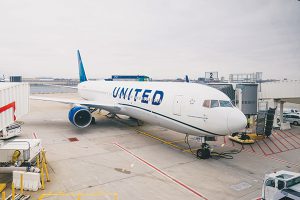Bloomberg
United Airlines Holdings Inc threatened to suspend service at New York’s John F. Kennedy International Airport unless federal regulators review runway use and allow the carrier to increase daily operations.
The airport’s total flight capacity hasn’t changed since 2008, despite a widening of runways and other infrastructure improvements, United told employees in a memo about its plan. The airline, which has two daily flights between Los Angeles and JFK, and two shuttling back and forth to San Francisco, said it would suspend operations at end of October without more slots.
“That would obviously be a tough and frustrating step to take and one that we have worked really hard to prevent,†the carrier said. United resumed service at JFK in 2021 and said it has made repeated requests to the Federal Aviation Administration to expand operations.
United leased the rights to 40 daily takeoffs and landings at JFK to Delta Air Lines Inc. in two transactions in 2014 and 2015, when it left the airport to consolidate transcontinental flying at its nearby Newark, New Jersey, hub. The long-term nature of the leases means United has no access to them for the foreseeable future, the carrier said. Delta didn’t immediately comment on the leases after normal business hours.
Any new flights added at JFK would have to be distributed “fairly,†the FAA said in an emailed statement, meaning there would be no guarantee that United would receive
additional slots.
“The FAA continually looks for ways to increase the efficiency of airspace in busy metropolitan areas safely,†the FAA said. “The agency must consider airspace capacity and runway capacity to assess how changes would affect flights at nearby airports.â€
While JFK may be able to handle some additional takeoffs and landings, if more flight volumes were added to the New York area — already one of the most congested in the US — it would cause additional tie-ups in the region.
United cut 50 daily flights from Newark Liberty International Airport earlier this year to ease disruptions caused by a number of factors, including construction, and accused two discount carriers of scheduling too many flights.
Meanwhile, United raised its outlook for third-quarter sales and said it may fly slightly more than previously planned, boosting shares across the industry as the carrier cited strong demand holding steady even as the summer travel season comes to an end.
Operating revenue will be up about 12% in the period compared with the same quarter in 2019, according to a filing. United had previously forecast an increase of about 11%.
The airline also sees an adjusted operating margin of about 10.5%, higher than its prior estimate of 10%.
“We’re seeing a really strong September,†Patrick Quayle, United’s senior vice president for global network, planning and alliances, said at a Cowen Inc. transportation conference. “It does not appear summer has come to an end, it is that strong.â€
United’s revised forecast marks a step forward in the industry’s choppy recovery from an early-pandemic slump. US airlines have faced a variety of challenges, including soaring fuel costs and staff shortages, that have hampered their ability to take full advantage of a rebound in travel demand.
Premium leisure demand and higher fares are fueling improvement, along with a strong surge in travel following the reduction of coronavirus-related restrictions in parts of Asia Pacific, including Singapore and Korea, Quayle said. While the number of corporate passengers remains below 2019, revenue is in line or higher than it was, he said.
The airline said in the new filing that it would fly in the third quarter as much as 90% of 2019 levels. It had previously predicted about 89%. That comes after widespread capacity reductions by US carriers in recent months as they struggled to ease flight disruptions that snarled operations earlier in the summer.
United said in July that it would hold flying capacity this year to 13% below pre-pandemic levels, and that capacity in 2023 will be no more than 8% higher than 2019, far short of the 20% jump United had previously planned. The airline said then that the reductions won’t change its expectations for continued profit — including for the full year — based on solid pricing and even stronger demand.
Operating costs for each seat flown a mile, excluding fuel, have been in line with or slightly better than original expectations and will now rise about 16% in the quarter from 2019. That compares with a prior prediction of as much as 17%. Revenue on the same basis will increase 25%, in line with an earlier outlook.
 The Gulf Time Newspaper One of the finest business newspapers in the UAE brought to you by our professional writers and editors.
The Gulf Time Newspaper One of the finest business newspapers in the UAE brought to you by our professional writers and editors.
